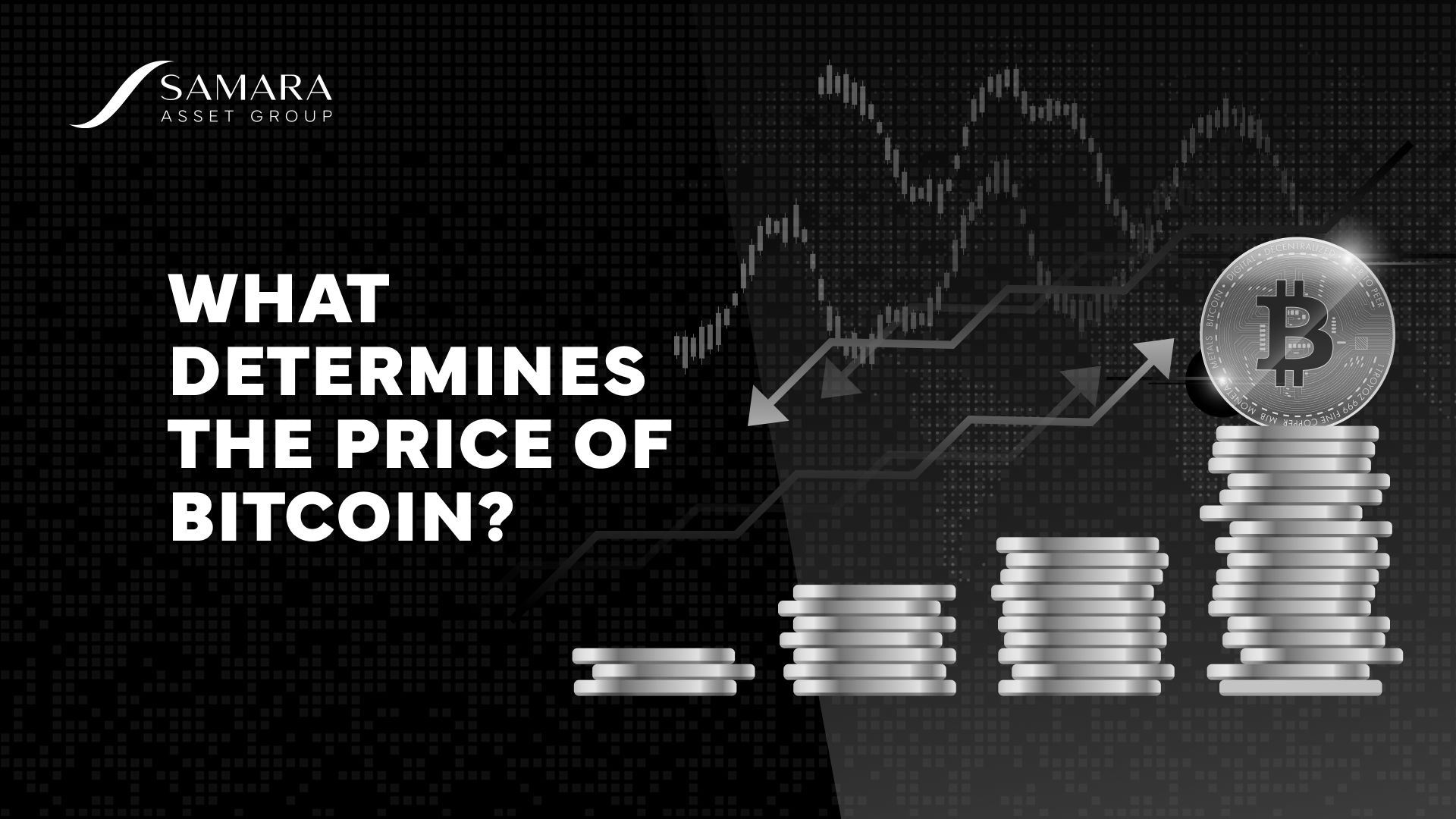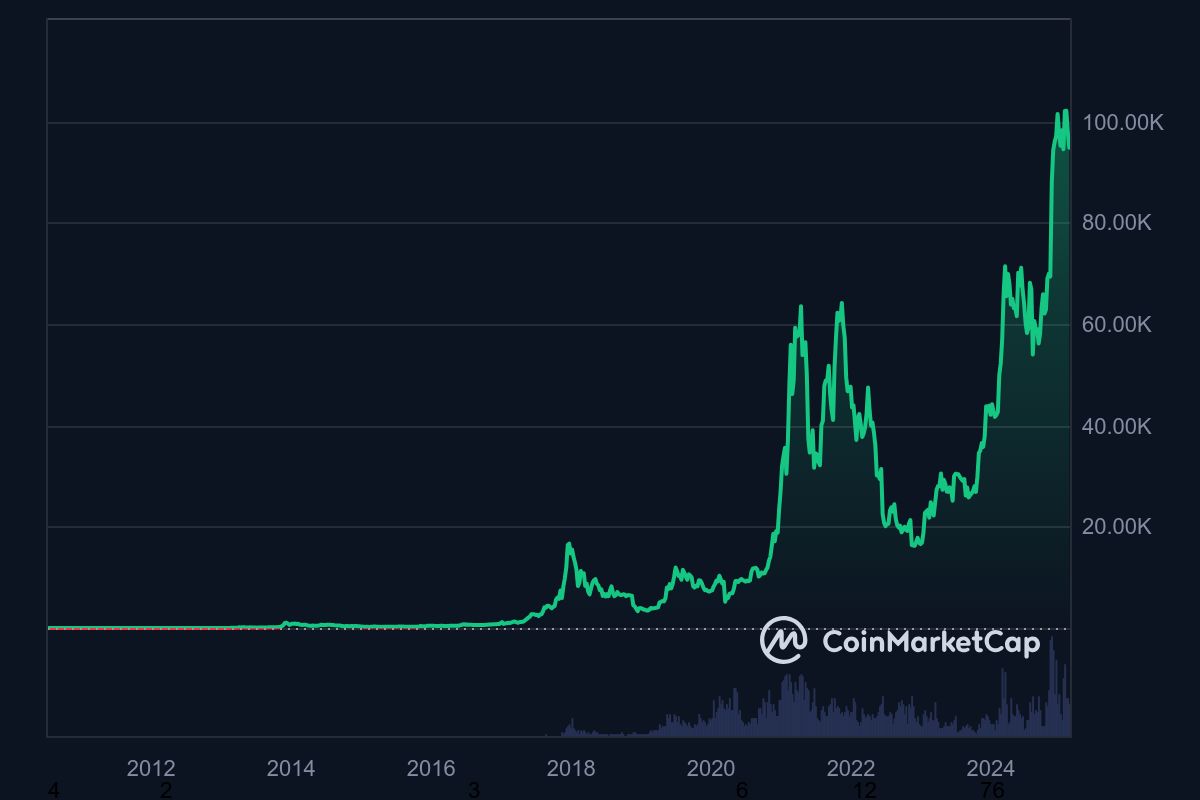Bitcoin
Bitcoin CPI
Venture Portfolio
Funds
Market Insights
Indicators
About
Contact

March 10, 2025





The price of Bitcoin has steadily increased since its launch in 2009. However, over this period, Bitcoin has earned a reputation for being a volatile asset, given its sharp and often unpredictable swings in price.
In this guide, we’ll examine the forces that determine the price of Bitcoin, notably supply and demand, media sentiments, regulatory and geopolitical factors, the cost of mining, and trends in other asset markets.
As with the value of most other assets, the forces of supply and demand significantly determine the price of Bitcoin.
However, there is a unique aspect to how supply and demand play out when it comes to Bitcoin, namely, the fact that the rate of new Bitcoin issuance is predetermined to decline systematically over time.
This is the function of the Bitcoin halving. About every four years, or more specifically, after 210,000 blocks are mined, the amount of new Bitcoin that comes into circulation is cut by half.
The halvings are built into Bitcoin’s monetary policy. They are part of the rules that are programmed into the protocol that guides the operations of the Bitcoin network and are nearly impossible to change.
When Bitcoin launched in 2009, 50 BTC came into circulation with every block that was mined. This amount was given to miners as a reward for their trouble keeping the network running. The first halving event happened in November 2012, decreasing the reward to 25 BTC for every block mined. Since then, the number has dropped to 12.5 BTC (in 2016), 6.25 BTC (in 2020), and now 3.125 BTC (in 2024).
This trend reduces the supply of Bitcoin over time. Historically, there has been a correlation between the halving cycles and the price reaching new all-time highs not long after each, as seen in the following chart:

If the demand for Bitcoin continues to grow, its price will likely keep rising.
Continued growth is expected as more people learn about Bitcoin and new use cases are developed. Concurrently, Bitcoin is becoming scarcer, which adds further upward pressure on its price.
Bitcoin has become a popular topic in mainstream media. Consequently, the stories the media reports often affect investors’ confidence in the cryptocurrency.
When these stories are positive, more money is likely to come into the asset, driving the price upwards.
For example, increased positive media coverage about the Securities Exchange Commission (SEC) approving the spot Bitcoin ETFs in the U.S. in early 2024 helped drive the price from under $40,000 to over $70,000 in three months.
It is important to point out that media has expanded to include social media. Many people today turn to digital media for information. It happens that Bitcoin is a popular topic on those platforms, and engaging discussions about it are often held there.
While Bitcoin is decentralized and global, its price is influenced by the actions of regulators, policymakers, and government officials from around the globe.
For example, the election of pro-crypto President Donald Trump in 2024 caused the price of Bitcoin to rally by over 15% on election night alone. In less than two months, bitcoin price crossed the $100,000 mark for the first time.
In the months leading to the election, Donald Trump had expressed his support for Bitcoin. His promise to form a task force to not only establish a regulatory framework that is friendly towards digital assets but also explore the possibility of setting up a strategic Bitcoin reserve has been another positive policy influence on the price of Bitcoin.
Regulatory clarity has generally been lacking in most jurisdictions, hindering the adoption of Bitcoin and innovations around its use. As more countries take steps to accommodate the digital currency, its price is likely to receive a further push.
The cost of mining Bitcoin does affect its price, though not directly
Mining requires a significant amount of energy and expensive hardware. This cost of operation has often been considered the price floor for Bitcoin.
Mining ceases to be profitable when the price of Bitcoin drops to the point where miners can't recoup their expenses from the proceeds of their reward. This can trigger a chain reaction that ultimately puts pressure on the Bitcoin price.
For example, when the price drops below the floor, many miners, especially those with less efficient operations, are forced to shut down. Those who remain in business will often be forced to HODL their coins and wait for better prices. This can translate to low supply on the exchanges, which could push the price up.
That means that while mining costs don’t directly affect Bitcoin’s price, they contribute to the complex interplay of supply and demand.
The price of Bitcoin is often affected by what is happening in other financial markets.
Bitcoin has shown some correlation with other assets, such as tech stocks. Investors treat Bitcoin like a risk-on/risk-off asset, especially when the markets are more liquid—mainly during rapid M2 money supply increases. When the markets are uncertain, Bitcoin is often one of the first assets to see a large sell-off or correction.
While Bitcoin may not be directly correlated with other assets, it is intertwined with the rest of the financial markets, and what happens to one asset class is likely to affect Bitcoin's price in some way.

Since its inception in 2009, Bitcoin has made great strides, especially in terms of price growth. The increasing demand for an ever-decreasing supply has also experienced significant price swings.
Many factors determine the price of Bitcoin, each of which plays a vital role. As Bitcoin matures and gains mainstream acceptance, these factors will likely evolve, and maybe new ones will emerge.
The value of Bitcoin comes from market trust and adoption, built-in scarcity with a decrease in inflation every four years, and the security of its decentralized network. While these factors contribute to Bitcoin's value, its price can be volatile since it's driven purely by market supply and demand.
Bitcoin’s supply of 21 million coins will eventually be mined. The Bitcoin blockchain produces a new block with fresh BTC roughly every ten minutes, and its value halves every four years. Based on that schedule, the last Bitcoin will be mined around 2140. Once that is the case, miners won’t be able to mine new Bitcoin but will be incentivized by the fees that users of the network pay to have their transactions processed.
Bitcoin isn’t a company or a centralized business that needs to make a profit. However, actors on its network, particularly miners, are compensated. They earn newly mined Bitcoin for each block they generate and collect fees that users of the network pay.